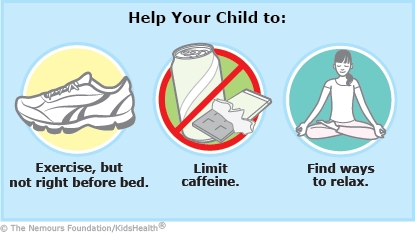Restless Legs Syndrome: How to Care for Your Child
Restless legs syndrome (RLS) can make it hard to sleep. Treatment can help your child be more comfortable and sleep better.


When kids with RLS sit or lie down for a while, they can get uncomfortable feelings in their legs or arms, such as tingling, itching, crawling, pain, or burning, with the urge to move. Moving their arms or legs gets rid of these feelings.
The need to move often gets stronger at night and may keep a child from falling asleep. Some kids with RLS also move their limbs while they are sleeping. These movements are jerky and may wake a child up.
Health care providers often treat RLS with lifestyle changes and/or medications. Getting more sleep, exercising, establishing good bedtime habits, using relaxation techniques, and making other lifestyle changes can help reduce RLS symptoms. For some kids, treating an iron deficiency can make the condition go away. Sometimes other medications are recommended.

-
Give your child any prescribed medicine or iron supplements as directed.
-
Daily exercise and active playtime can help reduce symptoms of RLS. But kids should relax after dinner, since high-energy activity near bedtime can make it harder to fall asleep.
-
Limit caffeine (found in coffee, tea, soda, and chocolate), especially in the afternoon and evening. It can make RLS symptoms worse.
-
Once in bed, your child should not watch TV, use electronics, or read.
-
Your child should not smoke, use tobacco products, or be around secondhand smoke. If anyone in the household smokes, call 1-800-QUIT-NOW for advice on quitting.
-
Work with your child to set a consistent bedtime and wake-up time that allows for enough sleep. Make sure your child gets enough sleep for his or her age:
-
2 years old: 12 hours of sleep (including one nap)
-
5 years old: 11 hours of sleep
-
10 years old: 10 hours of sleep
-
During adolescence: 9 hours of sleep
-
The health care provider may make different recommendations based on your child's individual needs.
-
If your child is under stress, help make a plan to reduce the stress. Relaxation techniques like yoga can help.
-
When your child has RLS symptoms, massaging the limbs and using heating pads or cool compresses may help.

-
Make a follow-up appointment with your child's health care provider as directed.
-
If RLS symptoms happen during the day, talk to teachers or daycare providers about giving your child opportunities to move about.

Your child:
-
Is very sleepy during the day.
-
Is having a hard time in school.
-
Seems depressed, anxious, or moody.
-
Develops new symptoms.

Too much iron can be toxic. Do not give your child an iron supplement unless told to by your health care provider. Keep iron supplements and other medicines in a locked medicine cabinet out of young children's reach.